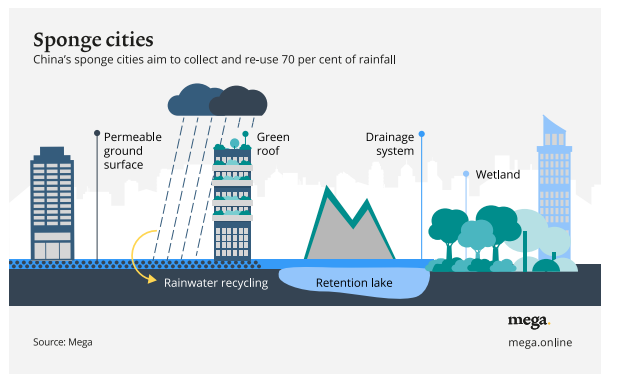China's water revolution
Published on by Asit Biswas, Distinguished Professor at University of Glasgow in Case Studies
Asit K. Biswas and Cecilia Tortajada
Some 15 years ago, China tried to improve its water management policies to reduce impacts of devastating floods, extensive pollution and poor water management practices.
During the past decade, it has managed its water policies that suits best its governance system. Much of these advances are not known to the West. China has made commendable progress during this period in regulatory oversights and in new ways of managing water, including use of new technologies and management practices.
We discuss three aspects only. First is sponge cities that reduces rainwater runoff to rivers by expanding absorptive capacities of urban areas. This includes construction of artificial wetlands for rainwater storage, rooftop gardens, permeable pavements, and raingardens. Goal is 80% of urban areas will absorb and reuse at least 70% of rainwater. Second, is river chiefs systems that was successfully used in cleaning up Lake Tai. This system has been rolled out all over the country. Third is use of robotics and artificial intelligence to improve water management where it is some 10 years ahead of any other country. See our views.
China's water revolution By developing and expanding ‘sponge cities’, China is showing the world how to manage its water resources. April 2020 By author Prof. Asit K. Biswas and Cecilia Tortajada
More than a decade ago, China decided to take a long hard look at the way it managed it water resources. Its aim was to put an end to the devastating floods and pollution that had long blighted the country and held back its economic development. The result has been nothing short of revolutionary. In just 15 years, China has gone from being behind the curve to a world leader in in water-related technology and regulatory oversight.
Here we look at three areas in which China has played a pioneering role, and where the rest of the world might be able to learn from its example.
1. Sponge cities Rapid urbanisation had steadily reduced the land in cities which could absorb rainwater, not least through the filling up of wetlands and lakes. Impermeable construction materials exacerbated the problem, leading to a series of severe urban floods. China’s response was both ambitious and innovative – sponge cities.

The rollout of ‘sponge city’ technology to China’s metropolises reduces rainwater runoff by expanding and enhancing the absorption capacity of urban areas. This not only helps reduce flooding but also contributes to water security. An additional benefit of sponge city expansion is the cooling of temperatures in China’s urban districts. With sponge cities, the goal is to ensure 80 per cent of China’s urban areas will absorb and reuse at least 70 per cent of rainwater, at an estimated cost of CNY 1.6 trillion.
New cities are being planned, and existing ones will be expanded. Each will feature artificial and scenic wetlands for rainwater storage, rooftop gardens in buildings, permeable pavements than can effectively percolate and store .
2. Robotics and artificial intelligence Chinese companies have made remarkable advances in robotics, artificial intelligence and big data analytics. And many have deployed such technologies to good effect in the water industry.
One of the most successful is Dadu River Hydropower Development Company of Chengdu, which is probably 10 years ahead of any other public or private sector company anywhere in the world. The company is responsible for planning, construction and management of 28 large hydropower dams on the Dadu River, a tributary of the Yangtze River, rainwater, and rain gardens where people of all ages can interact with nature. Sponge city projects in Wuhan, Xiamen, Lingang and Suining have already performed well during heavy rainfalls. generating hydropower through a cascade of dams. Since generating capacities of the dams generally are higher than grid capacities, certain amounts of water from individual dams have to be released without generating electricity.
Artificial Intelligence helps achieve this by analysing hydrologic, economic, power grid capacities and demand considerations to make real time decisions. Equally impressive has been the use of robotics. Robots are continuously moving inside the dams, collecting data from various sensors which are immediately transmitted to a central data system. Even workers’ hard hats receive data from sensors. All this information is analysed immediately to improve the performance of their systems.
3. River chiefs Technology is important, but clearly setting out the responsibility for water management has also played a major part in driving China’s progress. A key part of that is the river chief system. The idea was first tested in Lake Tai in central China, which was polluted by blue-green algae. The algae threatened the provision of drinking water to more than five million people.
Specific individuals were given the responsibility for managing water quality for specific areas. In just two months, water quality started to improve markedly and progress continued. Greenpeace East Asia noted that proportion of surface water fit for human use in Jiangsu province, within which the lake is located, improved from 35.5 per cent in 2011 to 63.9 per cent in 2016.
After this successful experiment, river chiefs were appointed in a number of other areas. Impressed by the results from these pilot studies, China expanded the scheme country-wide. There are currently four levels of river chiefs - for villages, counties, cities and provinces. Each river chief is assigned a specific area of a river or lake. Each province has a provincial river chief who is invariably a leader of the provincial government. So just as China industrialised itself in little over 35 years to become second most important global economic power, we are convinced it will solve its water and air pollution problems in about 10 years, a significantly shorter period than it will take major Western nations to do the same.
https://mega.online/en/articles/water-efficiency-examples-in-china
Media
Taxonomy
- Technology
- Water Resources
- Wetlands
- China
- Rainwater Harvesting